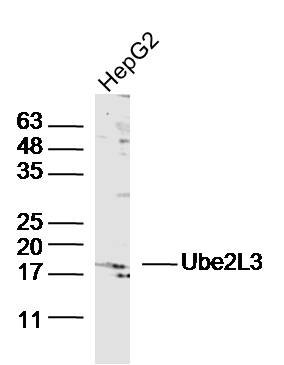
Rabbit Anti-Ube2L3 antibody
E2 F1; E2-F1; L UBC; L-UBC; UB2L3_HUMAN; UBCE7; UbcH7; UbcM4; Ube2l3; Ubiquitin carrier protein L3; Ubiquitin conjugating enzyme E2 L3; Ubiquitin protein ligase L3; Ubiquitin-conjugating enzyme E2 L3; Ubiquitin-conjugating enzyme E2-F1; Ubiquitin-protein
View History [Clear]
Details
Product Name Ube2L3 Chinese Name Ubiquitin蛋白连接酶L3抗体 Alias E2 F1; E2-F1; L UBC; L-UBC; UB2L3_HUMAN; UBCE7; UbcH7; UbcM4; Ube2l3; Ubiquitin carrier protein L3; Ubiquitin conjugating enzyme E2 L3; Ubiquitin protein ligase L3; Ubiquitin-conjugating enzyme E2 L3; Ubiquitin-conjugating enzyme E2-F1; Ubiquitin-protein ligase L3. Research Area Cell biology Signal transduction Epigenetics Immunogen Species Rabbit Clonality Polyclonal React Species Human, (predicted: Mouse, Rat, Cow, Horse, Rabbit, Zebrafish, Sheep, ) Applications WB=1:500-2000 ELISA=1:5000-10000 IHC-P=1:100-500 IHC-F=1:100-500 IF=1:50-200 (Paraffin sections need antigen repair)
not yet tested in other applications.
optimal dilutions/concentrations should be determined by the end user.Theoretical molecular weight 18kDa Cellular localization The nucleus cytoplasmic Form Liquid Concentration 1mg/ml immunogen KLH conjugated synthetic peptide derived from human Ube2L3: 81-154/154 Lsotype IgG Purification affinity purified by Protein A Buffer Solution 0.01M TBS(pH7.4) with 1% BSA, 0.03% Proclin300 and 50% Glycerol. Storage Shipped at 4℃. Store at -20 °C for one year. Avoid repeated freeze/thaw cycles. Attention This product as supplied is intended for research use only, not for use in human, therapeutic or diagnostic applications. PubMed PubMed Product Detail The ubiquitin (Ub) pathway involves three sequential enzymatic steps that facilitate the conjugation of Ub and Ub-like molecules to specific protein substrates. The first step requires the ATP-dependent activation of the Ub C-terminus and the assembly of multi-Ub chains by the Ub-activating enzyme known as the E1 component. The Ub chain is then conjugated to the Ub-conjugating enzyme (E2) to generate an intermediate Ub-E2 complex. The Ub-ligase (E3) then catalyzes the transfer of Ub from E2 to the appropriate protein substrate. UBE2E1 and UBE2L3, also designated UBCH6 and UBCH7 respectively in human, are E2 conjugating enzymes that interact with various proteins. Specifically, UBE2E1 interacts with the tumor suppressor protein TSSC5. UBE2L3 has been shown to mediate c-fos degradation, NF-kB maturation, human papilloma virus-mediated p53 and Myc protein degradation.
Function:
Ubiquitin-conjugating enzyme E2 that specifically acts with HECT-type and RBR family E3 ubiquitin-protein ligases. Does not function with most RING-containing E3 ubiquitin-protein ligases because it lacks intrinsic E3-independent reactivity with lysine: in contrast, it has activity with the RBR family E3 enzymes, such as PARK2 and ARIH1, that function like function like RING-HECT hybrids. Accepts ubiquitin from the E1 complex and catalyzes its covalent attachment to other proteins. In vitro catalyzes 'Lys-11'-linked polyubiquitination. Involved in the selective degradation of short-lived and abnormal proteins. Down-regulated during the S-phase it is involved in progression through the cell cycle. Regulates nuclear hormone receptors transcriptional activity. May play a role in myelopoiesis.
Subunit:
Interacts with PARK2; involved in ubiquitination and degradation of misfolded proteins. Interacts with UBE3A; used by the papilloma virus HPV-16 E6 protein to ubiquitinate p53/TP53. Interacts with CCNB1IP1, CBL, ZAP70, RNF19A, RNF19B and RNF144B. Interacts with ARIH1. Interacts with ARIH2 (via RING-type 1). Interacts with NCOA1; they functionally interact to regulate progesterone receptor transcriptional activity. May interact with NR3C1.
Subcellular Location:
Nucleus. Cytoplasm.
Tissue Specificity:
Ubiquitous, with highest expression in testis.
Post-translational modifications:
Ubiquitinated. The alteration of UBE2L3 protein levels during the S-phase of the cell cycle is due to ubiquitin-dependent proteasomal degradation.
Similarity:
Belongs to the ubiquitin-conjugating enzyme family.
SWISS:
P68036
Gene ID:
7332
Database links:Entrez Gene: 7332 Human
Entrez Gene: 100042355 Mouse
Entrez Gene: 22195 Mouse
Omim: 603721 Human
SwissProt: P68036 Human
SwissProt: P68037 Mouse
Unigene: 108104 Human
Unigene: 603229 Human
Unigene: 3074 Mouse
Unigene: 163186 Rat
Product Picture
References (0)
No References
Bought notes(bought amounts latest0)
No one bought this product
User Comment(Total0User Comment Num)
- No comment



 +86 571 56623320
+86 571 56623320
 +86 18668110335
+86 18668110335

